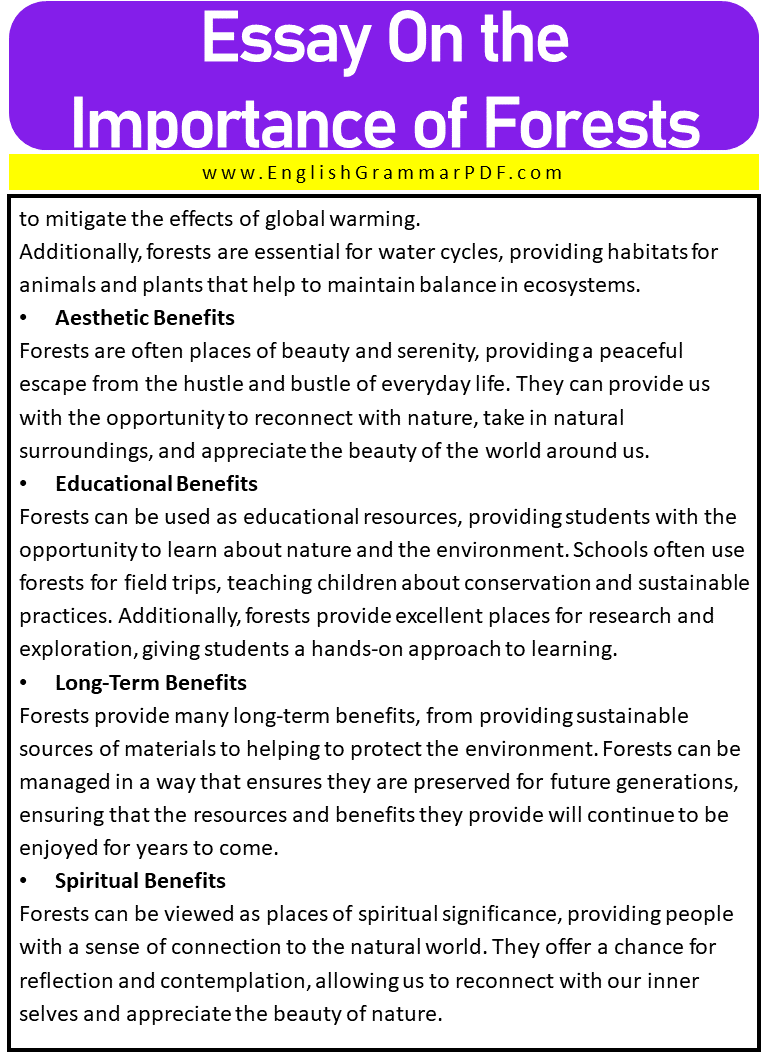Essay On the Importance of Forests
Outline of Essay
- Introduction
- Economic Benefits
- Environmental Benefits
- Cultural Benefits
- Social, Ecological Benefits
- Aesthetic, Spiritual, and Educational Benefits
- Long term Benefits
- Soil Erosion
- Why are forests called green lungs?
Introduction
Forests are a valuable resource for all of humanity. They provide many essential resources, such as food, shelter, and medicine, that are vital to sustaining life on this planet. Forests cover nearly one-third of the earth’s land surface and provide habitats for countless species of wildlife. Not only do forests benefit people directly, but they also play an important role in regulating climate and air quality. This essay will explore the importance of forests in the world today, and discuss why they should be preserved and protected.
Major Benefits of Forests
- Economic Benefits
Forests are an important economic resource, providing jobs and materials for many industries. Wood is a major component in the construction industry, while paper products are used to produce books, newspapers, and other items. Other products derived from forests include rubber, resin, honey, oil, and many more. In addition to these resources, forests also provide people with an array of recreational activities, such as hiking, camping, and fishing.
- Environmental Benefits
Forests play an important role in sustaining the environment by providing oxygen and absorbing carbon dioxide from the atmosphere. Trees also help to regulate global climate, as well as conserve soil and water resources. By preventing soil erosion, forests protect surrounding communities from flooding and other natural disasters.
- Cultural Benefits
Forests are an important part of many cultures across the world, providing spiritual and religious significance for many people. Additionally, forests can be used as places for writing, painting, and other forms of art. They can also be used as places for people to gather and talk about matters that are important to them.
- Social Benefits
Forests provide a wide range of social benefits, from psychological comfort to physical health. Spending time in nature has been shown to reduce stress levels and improve mental health, while providing people with the opportunity for physical exercise. Additionally, forests act as buffer zones between urban areas and can help reduce noise pollution.
- Ecological Benefits
Forests provide many ecological benefits, from preserving biodiversity to maintaining a healthy climate. Forests act as natural carbon sinks, absorbing and storing carbon dioxide in the atmosphere and helping to mitigate the effects of global warming.
Additionally, forests are essential for water cycles, providing habitats for animals and plants that help to maintain balance in ecosystems.
- Aesthetic Benefits
Forests are often places of beauty and serenity, providing a peaceful escape from the hustle and bustle of everyday life. They can provide us with the opportunity to reconnect with nature, take in natural surroundings, and appreciate the beauty of the world around us.
- Educational Benefits
Forests can be used as educational resources, providing students with the opportunity to learn about nature and the environment. Schools often use forests for field trips, teaching children about conservation and sustainable practices. Additionally, forests provide excellent places for research and exploration, giving students a hands-on approach to learning.
- Long-Term Benefits
Forests provide many long-term benefits, from providing sustainable sources of materials to helping to protect the environment. Forests can be managed in a way that ensures they are preserved for future generations, ensuring that the resources and benefits they provide will continue to be enjoyed for years to come.
- Spiritual Benefits
Forests can be viewed as places of spiritual significance, providing people with a sense of connection to the natural world. They offer a chance for reflection and contemplation, allowing us to reconnect with our inner selves and appreciate the beauty of nature.
- Soil Erosion
Forests play an important role in soil erosion control, as trees act as a barrier that absorbs water and slows its movement across the land. This helps to reduce runoff and prevent soil from being washed away by rivers or streams. Additionally, tree roots help bind together loose topsoil, helping to prevent it from being blown away by wind or washed away by rain.
Why Forests are called Green Lungs?
Forests are often referred to as the “Green Lungs” of the planet due to the vital role they play in maintaining a healthy environment. Trees and other plants absorb carbon dioxide from the atmosphere, releasing oxygen in exchange.
(1) This process helps to regulate the climate, as well as improve air quality by filtering out pollutants.
(2) Additionally, forests act as natural carbon sinks, helping to mitigate the effects of global warming.
(3) Forests also play an important role in water cycles and provide essential habitats for many species of animals and plants.
(4) By providing these benefits, forests help to maintain a balance in our ecosystems and ensure long-term sustainability.
(5) Ultimately, forests play an important role in maintaining a healthy environment and ensuring the health of future generations.
Forests also act as natural sponges, storing and controlling the flow of water into rivers and streams. In addition to this, forests play a key role in biodiversity by providing habitats for animals and plants. All these benefits make forests an essential part of our global environment, making it vital that they are preserved and protected.
FAQ’s
What is the structure of the forest?
Forests typically consist of trees, shrubs, and other woody plants. Additionally, they may also include non-woody plants such as ferns, mosses, lichens, and wildflowers.
What makes the forest grow?
Forests are sustained by a combination of sunlight, soil, water and other environmental factors. Trees receive energy from the sun through photosynthesis, which allows them to grow and reproduce. Water is necessary for photosynthesis as well as other physiological processes such as transpiration and respiration.
How long is a forest for the trees?
The life span of trees can vary greatly depending on the species, with some living for centuries while others may live only a few decades. Additionally, many factors such as climate and soil quality can also affect the longevity of forests.
Download Pdf of Essay On the Importance of Forests






More Essays:


